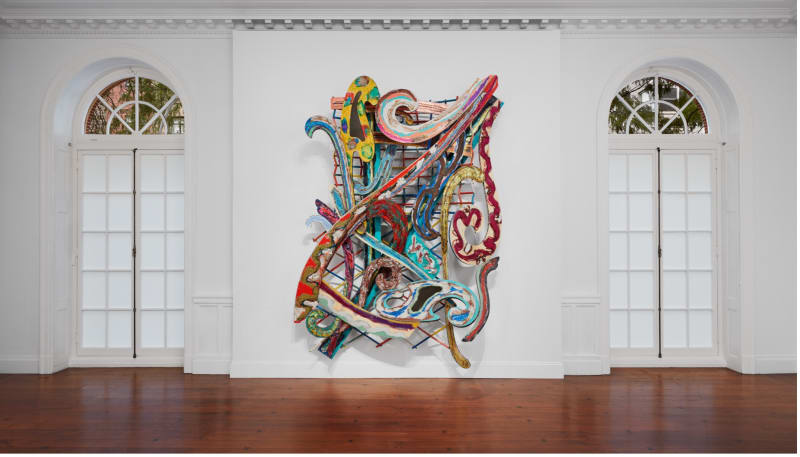BY BRUCE HELANDER
In an historic first, Mnuchin Gallery in New York City is exhibiting six of Frank Stella’s constructions titled “Indian Birds,” prompted by his 1977 trip to Ahmedabad, India, as well as the renowned innovator’s fascinating archival drawings and maquettes for this memorable series. It is one of the most beautiful exhibitions in Manhattan during the fall art season, and the presentation, which focuses on a singular body of work, illuminates Stella’s singularly intricate and multi-layered artistic process right from the get-go. It also is a particularly enjoyable and fascinating revelation to view an artist’s initial drawings and scale models alongside the finished larger works, as it is a delightful insight into Stella’s modus operandi.
There is an honored tradition of artists first testing ideas, shapes and figural poses on a small theoretical scale to assess new forms and ideas prior to a more substantial assembly. Sculptors Henry Moore, Alexander Calder, Barbara Hepworth and Lynn Chadwick were particularly committed to initiating small-scale maquettes to streamline production and evaluate forms that eventually would be manipulated into monumental sculptural works. Adolph Gottlieb’s venture into creating models for large-scale sculptures, although short lived, generated a memorable body of work that, like Stella, challenged the delineation between painting and sculpture. Gottlieb began with small cut and painted maquettes using dry cleaner’s shirt boards and corrugated cardboard. These small objects, taped, stapled, bent, painted and molded by hand, were early conceptions that the artist conceived for large outdoor works. Also known as a “bozzetto” or “modello,” early three-dimensional tabletop models made as preparatory studies for full-size sculptures were a precursor to and influence on Stella’s vision and articulation of a transition from tiny assemblages to those with much bigger dimensions.
Frank Stella is best known as a minimalist who belonged to a small group of artists in the 1950s who rendered non-objective geometric forms rather than traditional artists’ interpretations of a landscape or still life. Stella’s method of working systematically in a series emphasized his problem-solving approach to painting. His logic, control and extreme reductionism prefigured minimalism. This exhibit underlines the talent of one of America’s most celebrated and prolific artists. Throughout his colorful career, he has investigated various styles and techniques that have defined fundamental art movements. In 1958, after graduating from Princeton, Stella moved to Manhattan and developed an interest in Abstract Expressionism, exploring the artworks of Jackson Pollock, Jasper Johns and Hans Hofmann. He first embraced Minimalism, using a monochromatic color palette and abstract geometric designs. Later, the artist moved away from Minimalism and into his own distinctive brand of Post-Abstract Expressionism. From geometric forms and simple lines to vibrant colors, curved forms and 3-D arrangements, Stella created a new design vocabulary, which was revolutionary and groundbreaking art as evidenced in this handsome and intimate exhibition.
It can be a challenge to describe the pictorial qualities and individual signatures of the Indian Birds series as Stella’s work encompasses a mixed bag of visual characteristics, intricate interwoven forms, brilliant colors, shapes, textures, painterly surfaces and welded wire packed with panache. Occasionally there appears to be a gentle sway of cut-out forms as if a determined breeze is pushing by, like a hurricane’s aftermath, elevating gravity as the shapes conspire to inaugurate an idiosyncratic graphic companionship. Often inspired and guided by an architect’s French curve template, which provides the artist with a common denominator of classic forms separate but equal, are repeated in each work on display. Frank Stella, the former art history major and calculated developer of a unique contemporary style, utilized his intuition to quickly advance his career, which continues to this day at age 87.
An odd coincidence is a comparison with Pablo Picasso’s 1907 masterpiece, Les Demoiselles d’Avignon, where an assemblage of cubistic Parisian nudes, depicted as flat geometric female forms, coincidently possess “French curves” a device that Stella utilized in a range of shapes and sizes as architectonic forms throughout his career. The visual ingredients and materialization in this survey also bring to mind the early cubist shapes of Georges Braque as well as vintage constructivists like Wassily Kandinsky, Hans Hoffmann and even Marcel Duchamp’s famous painting Nude Descending a Staircase. Stella, the historian, adventurer and imaginative explorer, was well aware of the family tree of those artistic pioneers that came before him and assimilated their daring character and determination for unique invention.
Frank Stella, a rare bird indeed who made his museum debut in MoMA’s “16 Americans” group exhibition (1959-1960) at age twenty-three, continues to push the boundaries of Post-war modern art and abstraction with eccentric flat compositions that gave way to giant collage-like configurations that changed and challenged the way we perceive contemporary art. This show elegantly encapsulates Stella’s well-established contributions to the American artistic tradition of original discoveries while balancing seriousness and playfulness, spatial illusion, tradition and innovation, meticulous construction connected to visual lavishness and intellectual consistency. The works on view in this outstanding exhibition are an enchanting viewing experience. This certainly is a Stellar performance not to be forgotten.
The exhibition continues through December 9, 2023 at Mnuchin Gallery, 45 East 78th Street, New York, NY 10075, T: (212) 861-0020. WM


